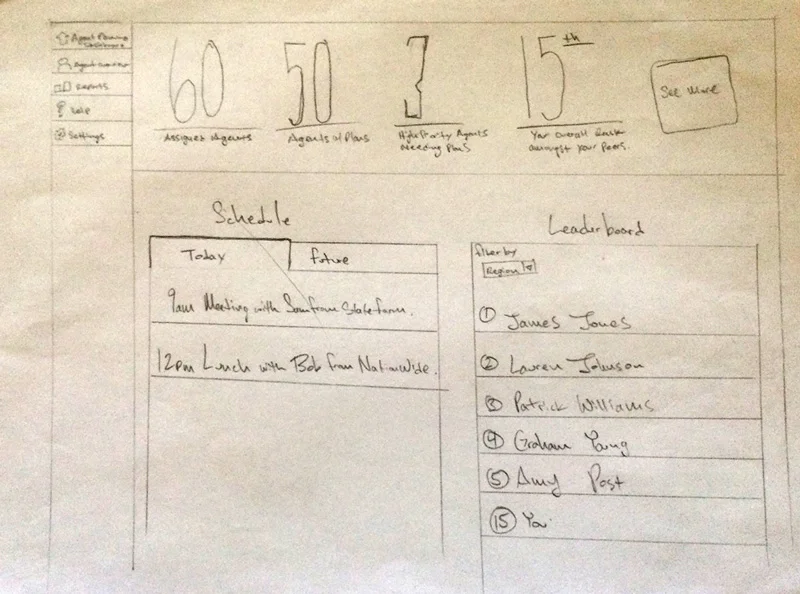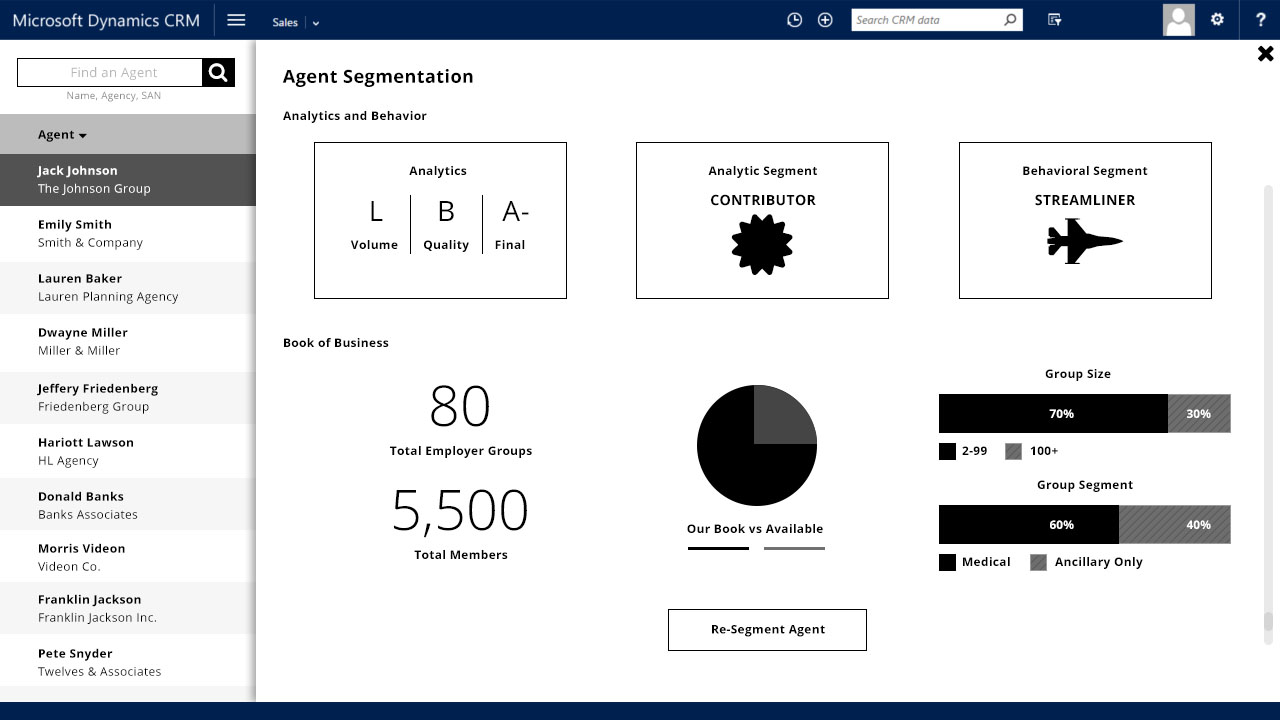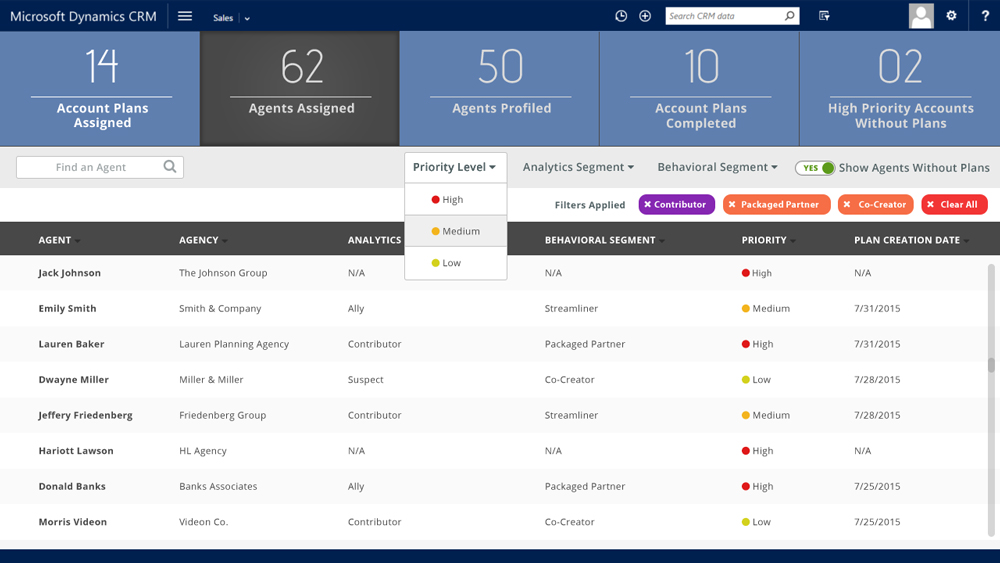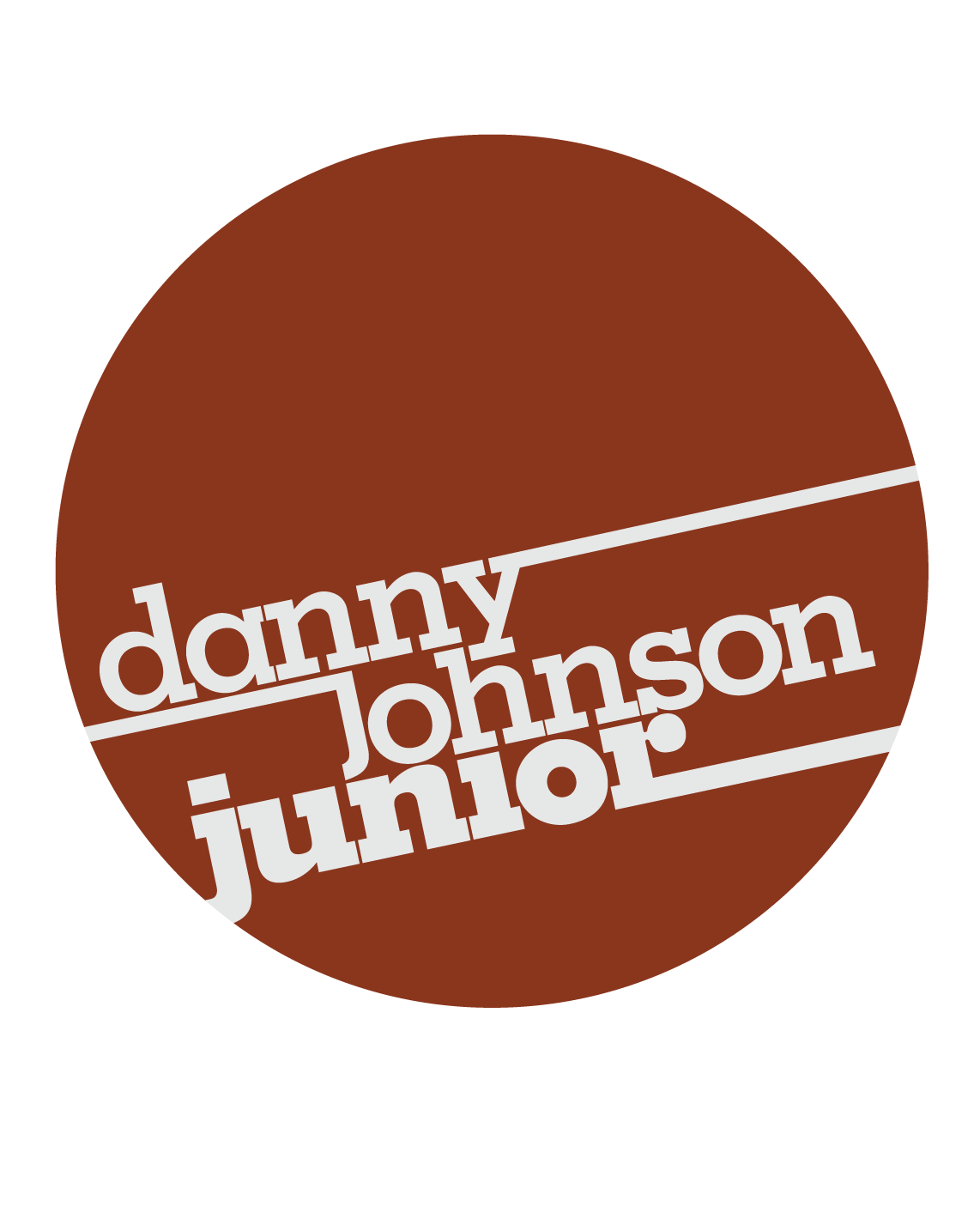Content and imagery has been modified, obscured or omitted to comply with NDA's.
agent management software
With a salesforce struggling to manage a massive network of clients, this major healthcare insurace provider was in dire need to build a product that would help leverage and surface data, set their agents up for success and allow them to win in this highly competitive market.
my role
Leading the design of this new product from concept to delivery. We flew out to our clients' offices in Chicago where we kicked off the project with intense discovery sessions and ending in Kirkland where we overcame a major shift in our deadline.

Discovery
Onsite with our client I lead core discussions around the end user and business objectives.

Concept Development
I lead the conversation around how the user experience needed to take shape.

Prototyping
With time being of the essence I opted for rapid prototyping through PowerPoint and AfterEffects.

Architecture & Design
Not only was I responsible for the core UX architecture but in addition I provided creative direction throughout the project.

Usability Testing
No time, no resources, no problem. I feel so strongly about validating design decisions that I always try to find a way to implement usability testing no matter how basic.
the challenge
TRANSFORMING HOW AGENTS MANAGED RELATIONSHIPS
Partnering with our project sponsor, he painted a very clear picture of how the current process was broken and how he wished to fix it. This organization serviced accounts with employees groups from small (1-99) to large (1,000+). Their existing solution was not scalable and couldn't accommodate the needs of agents in the field servicing these groups. Creating a new solution that was adaptable and allowed their sales force to service accounts whether they were helping 1 employee or 10,000 was a very real need.
Oddly enough the accounts that had the most issues were the small groups. Small group plans vary greatly with many options; managing all these plans and having education around them was key to the new solution.
Another hurdle to overcome was changing the perception with the senior sales leadership of what this tool could provide for the medium to large groups. The current system in place had poor user adoption and a bad reputation. Delivering a solution that was easy to use, provided solutions to core pain points and that would excite and engage users again was key to this project’s success.
Our challenge was to reimagine the agent to client relationship and deliver a design that would enable their sales force to be more lean and efficient. We had 3 months weeks to deliver a fully vetted user centered design.
the approach
FROM THE GROUND UP
After spending time onsite with the client we had a great understanding of the challenge in front of us to return home and immediately begin ideating. The final solution would be a highly tailored and customized version of Microsoft Dynamics CRM designed and implemented from scratch. I was in charge of leading the design efforts for a user centered design that was custom tailored to our clients sales force. It was critical that our solution was designed and architected in a sustainable, maintainable, and upgradable manner.
Working within the Dynamics CRM restraints required that I was constantly being conscious of what would be achievable and working closely with developers to define the art of possible.
CURVEBALL
3 days after returning home and cranking away on this project we got news that our project had been canceled. Our client was going through an acquisition and as a result there was a massive reorg. Any and all projects that weren’t beyond 75% complete were to be cut.
However, there was one caveat written into our contract. If we could provide tangible deliverables within 2 weeks we would at least get compensated for our efforts up until that point. If not, all efforts and time up until this point would go unpaid.
NEW GOALS, NEW CHALLENGES
In light of this new information I shifted the teams focus from long term vision to short term deliverables and redefined what was possible within the new timeframe. It was important that whatever we delivered in 2 weeks was still quality, well thought, and delivered on a user centered design approach.
One of the larger challenges was consolidating the schedule. User research, brainstorming, sketching, wireframing, and prototyping all had to be consolidated.
THE Vision
personal assistant
The vision for the solution was to enable the sales force with a powerful tool that would set them up for success and provide them with what would be the equivelant to a personal assistant.
This solution would allow the agents to manage all of their accounts, segment clients, assess client perceived and actual values, deeper insights to clients book of business, generate messaging and plans to focus on based of their client profile and give them key tips to win deals. Giving them incredicle insights they never had before and doing so in minutes vs hours.
Delivering on these core set of features was critical to the project's success and is what allowed us to deliver true value to our client.
THE Solution
Agent Management Platform
Agent management redefined. We pushed the boundaries of what Dynamics CRM is capable of achieving. We took its greatest weaknesses and designed a custom user experience that would work in tandem with its strengths. The new user experience drastically reduces time in the application. Not only freeing the agents to spend more face time with clients but simultaneously making them better salespersons through a focused and dedicated feature set.
Curated Contacts
An experience that is unattainable out of the box with Dynamics CRM. Agents can now quickly scan & view clients with a single click.
Segmenting Clients
An easy to use and efficient segmenting process that allows agents to quickly gain greater insight to their clients.
Key Account Analytics
Real time insights to their clients book of business and success metrics as a company within any given organization.
On The Fly Messaging Insights
Key messages to emphasize and tips to win deals, all automatically generated and curated for agents.
THE Process
How We Got To Done
With such an accelerated timeline and an unrealistic amount of activities to fully flush out, it was imperative to remind myself and team that “good enough” will take us across the finish line for this engagement. Good enough was defined as: Thoroughly designed for v1 in order to move into usability testing.
Knowing we were working against a hard deadline we worked backwards to define how much time we allotted for each activity.
Micro interaction design had to be cut, usability testing was a shell of what it should be, and product revision wasn't going to happen. Core UX architecture was our primary focus.
User Research
Thankfully we had several days of intense sessions where we interviewed the project sponsor and other key members of the organization. While leading conversations around why they needed a new tool we were able to capture a lot of useful user information. From these meetings we were able to create the user personas, scenarios, and capture what challenges they faced day in and day out while in the field and managing clients.
Having this jumpstart to the project truly allowed us to start ideating and brainstorming around what was important to the users and why they needed this tool.

Tiffany Lewis //Sales Associate//
Group Segment
Ground Pounder
Demographic
38 Year Old Female
Married
Bachelor's Degree
Goals and Tasks
Primary use is to see what products should be offered to clients and secondly to have insights into client segmentation types.
Questionnaire Sample: I created this questionnaire after the initial kick off meetings to help gain a greater understanding of our end users.
IDEATING
While ideating I continually encouraged our team to focus in on the why. Why does the agent enjoy their job? Why is it important to have face time with clients? Why do their clients like working with them? Why? Asking why tends to answer the how and the what. Asking the hard questions to begin with sheds light on how agents would interact with this program and what features would be useful.
It’s from these brainstorming sessions that we walked away with an understanding of how this product would begin to take shape.
At this point in the project we determined what functionality the program needed:
- Contact / Account management
- Segmentation process
- All in one contacts rollup
- Visibility into quantity of clients needing segmentation
- Analytics
- Targeted & curated messaging
Failing Quickly
We rapidly moved into wireframe mode. We had 3 core areas we needed to flush out.
- Segmentation
- Client Overview
- Account Overview
The challenge here was creating well thought out user flows within a very restricted timeframe. They key to our success here was focusing in during the analog stage. Staying agile with pen and paper we were able to very rapidly move through ideas and fail quickly. Quickly moving through ideas and concepts was critical for this projects succcess.





Our main purpose at this point was finding the solution that provided the most value for our client. At this stage we weren’t thinking about redesigning the wheel, our backs were up against it and innovation wasn’t a top priority. We focused in on past wins, what has worked well, and even things we have tried in the past that didn’t work well but may work for this project.
We spent a lot of time in this stage of fine tuning and refining. We only had v1 to get it right the first time. We knew that if we could quickly iterate and define exactly what the experience would be we could accelerate the creation of the digital wireframes.
Complete wireframe experience from login through client segmentation.
Testing
No Time Always time for usability testing
I can’t stress the importance of usability testing enough to project sponsors. I feel so strongly about validating designs that I try to incorporate it no matter what. This project we had no time or resources.
Even so, I still made an effort to squeeze in what I could. Without resources available I utilized my personal credits and account on usabilityhub.com to setup simple click tests.
In addition, I showed the designs to others and held mini moderated usability sessions. Yes I will be the first to admit that these sessions were not with the users that matched the profile of our target audience. However, like I said, I feel so strongly about validating designs that in this case it was my best and only option.
Assumptions
There were a few key assumptions I had that we could easily answer with the time and resources available.
Assumption #1: There is a high probability that users will confuse the search function from Dynamics CRM with the contacts search.
Assumption #2: With no strong call to action to view additional details, I was unsure if users would know where to find additional information about a contact.
Getting basic validation around how to navigate the interface was critical as well. To this point I asked users to completes some basic tasks like filtering and sorting.
Results
My assumption that the two search bars would confuse users was pretty sound. 30% of users clicked on the wrong area to search their contacts.
My assumption about users having a tough time finding additional details were put to ease. 83% of users correctly clicked to get more information about a contact.
96% of users successfully sorted contacts while 83% of users successfully filtered contacts by priority.
Delivery
Against the Odds we Exceeded Expectations
The acquisition of our clients company sent this project into a tailspin. Emotions ran the spectrum from riding the high of arriving onsite for the kick off meetings to the lows of hearing that our project was canceled. Through it all it was imperative to remain focused, positivie, and stay the course.
Our client truly couldn’t believe what we were able to turnaround in such a short amount of time. We delivered a fully flushed out v1 wireframe experience that was ready for proper usability testing, provided a proof of concept visual design to provide their team with a vision, and animated walkthroughs of the experience.
More important personally was our ability to provide guidance and understanding about taking a user centered design approach to our client. I strongly feel that a lot of what goes into UX design isn’t the final deliverables but the deep understanding one gets through the research, evaluations, and conversations around the business and its users.
Our client shared with us that even though the project was canceled that he would be delivering a full presentation to his fellow senior executives around the engagement and the potential that it has to bring the company.
Select wireframes and visual design interfaces






















